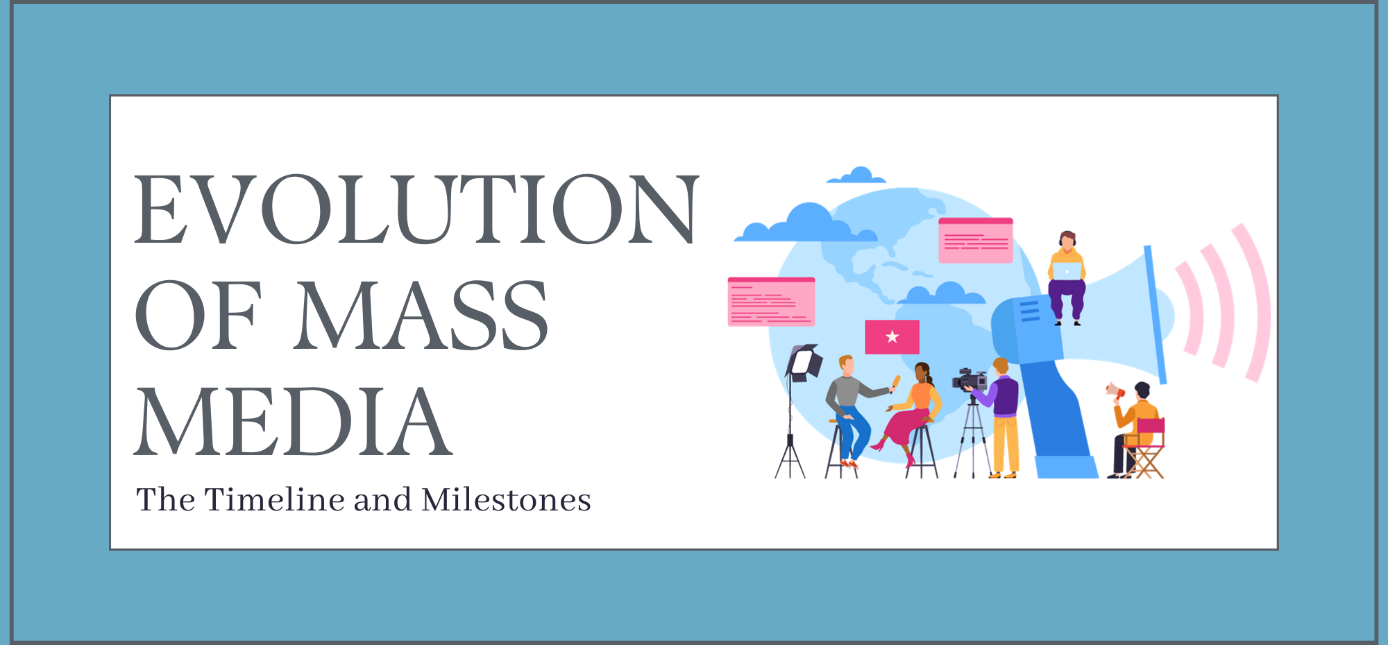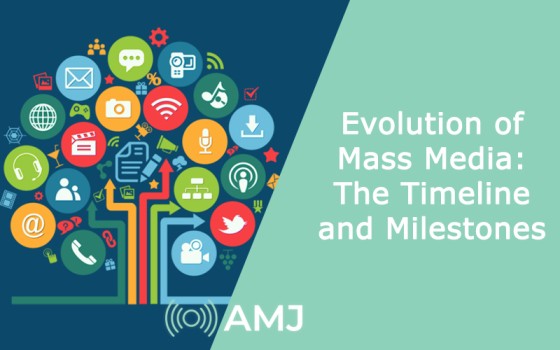
The evolution of mass media is a vibrant process that has been ongoing ever since with transformative milestones that reflect the requirements of global audience. With every technological advancement and even cultural shift, the way to manage mass communication has changed as well – making us notice the long way we went through until now – from the early days of the printing media to today’s internet era.
In this article, we will mention the timeline of this rich journey and remember the milestones that changed the media’s direction.
Contents
- 1 Gutenberg’s Invention and the Role of Print Media
- 2 The Impact of World War II on Mass Media Evolution
- 3 The Increasing Popularity of Radio and Television
- 4 Rise of Social Media Platforms
- 5 Impact of Cinema in the Mass Media Communication
- 6 Role of the Internet and World Wide Web in Mass Media
- 7 How Does the Media Evolution Affect Mass Communication Around the World?
- 8 FAQs about the Evolution of Mass Media
Gutenberg’s Invention and the Role of Print Media
The first introduction of the evolution of mass media started with the invention of Johannes Gutenberg – who is known as the person to launch the printing press in Europe in 1447. His invention made a revolutionary shift in information distribution, leading to the mass production of books and newspapers.
Gutenberg’s movable-type printing press enabled access to knowledge and sources across the world, giving a chance for a wider audience to reach the media. This naturally led the process to future evolutions, making new ways for the distribution of information throughout the media.
The Impact of World War II on Mass Media Evolution
The effect of World War II cannot be overlooked in the evolution of mass media and the ever-changing ways we communicate ever since – whether through a printing press or new media. During those hard times, people began to notice the influential power of mass media that covered the harsh reality of war on radio (invented by Guglielmo Marconi) and television.
The media delivered regular updates about global conflict into the living rooms worldwide, making the knowledge accessible to a broader audience. The growing interest in radio – and television managed to introduce the effect of media to people and laid the foundation for the enduring influence that would last for years to come.
The Increasing Popularity of Radio and Television
The post-war era marked another beginning for the evolution of mass media, and the world witnessed the widespread rise of television and radio as primary sources of news and additionally of entertainment. The head-to-head competition of popular TV channels, including CBS and NBC, brought the live coverage under spotlights.
Furthermore, political names started to appear on radio and television more – one of the most memorable ones being Senator Richard Nixon, who delivered the Checkers speech (Fund speech).
In addition to news, some brands started focusing on radio and television advertisements more as a marketing strategy. In fact, big brands such as Colgate and Coca-Cola sponsored some programs for TV ads to introduce their brands to a wider audience that enjoyed watching television and listening to the radio.
Rise of Social Media Platforms
The huge challenge to traditional forms of communication came with the rising popularity of social media platforms in the 21st century. Social networks such as Facebook, Instagram, and especially YouTube changed the audience’s perspective on the media by introducing new metrics such as users’ engagement and number of followers to go viral. In other words, for a person to acknowledge your message, you need to prove your reliability with your social media metrics.
In such cases, growth services like Views4You grasped the spotlight to bring strategic and organic solutions to help people grow their social media presence. For example, to increase your visibility and reliability, visit Views4You – and become one of the trustworthy names in the media.
Impact of Cinema in the Mass Media Communication
Alongside television and radio, cinema also played a crucial role in the evolution of new media at the introduction stage of visual storytelling that affected public opinion. Whether it’s a piece of information or an advertisement, the ability to deliver a story through moving images and catchy sounds reshaped the sense of entertainment in society.
Such that the culture went through an influential transformation with the narratives of iconic films, and many started to recognize a brand due to the catch tagline or sound from its sponsored advertisements.
Role of the Internet and World Wide Web in Mass Media
The mass media went through another milestone in the late 20th century and took a huge leap in the delivery of information and communication with the internet. Instead of waiting for hours and even days, people around the globe started to reach a piece of real-time information within seconds, which marked a paradigm shift in the methods of news and entertainment consumption. People no longer read a book but search for knowledge on the internet.
This new media destroyed the boundaries of traditional print and broadcast rules and began to shape today’s digital era – both for individuals and brands.
How Does the Media Evolution Affect Mass Communication Around the World?
From the invention of the telephone and the early days of print media in New York to the introduction of the internet, the evolution line of media has positively shaped the communication ways of people around the world. Technological advancement has contributed to the acknowledgment process of these new methods to deliver information and entertainment to society.
Throughout this positive transformation, media has transcended borders and managed to connect people and ideas around the globe in a short time and with just one click.
FAQs about the Evolution of Mass Media
Here are the most asked questions about media evolution:
What was the Most Significant Advantage of the Printing Press?
The most significant advantage was the ability to mass produce printed resources of news and give a wider audience easy access to them.
How Does Evolution Affect the Media Marketing?
At every stage of media evolution, marketing strategies are shaped as well. When radio, television, and cinema became more popular, brands started to focus on visual storytelling and the sound that completed it. When the internet became popular, their focus shifted to search engines and social media platforms for digital ads.
What was the First TV Advertisement?
The very first television advertisement was for Bulova Watch Company – and lasted nearly 10 seconds.












![Index of Money Heist [Season 1, 2, 3 & 4 – All Episodes, Cast and Plot] Index of Money Heist](https://www.asiamediajournal.com/wp-content/uploads/2021/05/Index-of-Money-Heist-3-100x70.jpg)